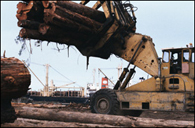|
Grain and Structure
The typical markings, called grain, that are found on all types
of natural wood are due to the structure of the wood. Wood consists essentially of fine cellular ducts or tubes,
which carry water and dissolved minerals from the roots to the leaves, and which are thus arranged more or
less vertically within the trunk. When the wood is cut parallel to the axis of the trunk,
straight-grained timber is usually produced. In some trees, however, the ducts are helical; that is,
they twist around the trunk as they ascend. Such trees produce cross-grained timber, which is also
obtained from ordinary trees when the cut is not parallel to the axis of the trunk.
Many woods have prominent annual rings. The trunk of a tree does not grow in length,
except at its tip, but does grow in width. The only portion of the trunk that is engaged in active growth
is the cambium, a thin layer entirely surrounding the trunk. In trees of the Temperate Zone, the
cambium lays down new wood during the spring and summer, and in most trees the early wood is more
porous and therefore lighter in colour than the wood produced later in the season. The trunk of a tree
is thus surrounded each year by a new pair of concentric sheaths, one darker than the other.
Although the thin layer of cambium is the only part of the trunk that is alive
in the sense that it is engaged in active growth, living cells are also interspersed among the xylem cells
of the sapwood. As the tree grows older, however, the central portion of the trunk dies completely;
the ducts become plugged with gums or resins, or merely air. This central part of the trunk is called heartwood. The internal
changes are accompanied by changes in colour typical of the species of trees, so that the heartwood is usually darker than the sapwood.
|



